5.8: Solving Trigonometric Equations
- Last updated
- Mar 28, 2022
- Save as PDF
- Page ID
- 99757
( \newcommand{\kernel}{\mathrm{null}\,}\)
In Section 6.1, we determined the height of a rider on the London Eye Ferris wheel could be determined by the equation
If we wanted to know length of time during which the rider is more than 100 meters above ground, we would need to solve equations involving trig functions.
Solving using Known Values
In the last chapter, we learned sine and cosine values at commonly encountered angles. We can use these to solve sine and cosine equations involving these common angles.
Example
Solve
Solution
Notice this is asking us to identify all angles,
Looking at a graph confirms that there are more than these two solutions. While eight are seen on this graph, there are an infinite number of solutions!

Remember that any coterminal angle will also have the same sine value, so any angle coterminal with these our first two solutions is also a solution. Coterminal angles can be found by adding full rotations of 2
Example
A circle of radius
Solution
The
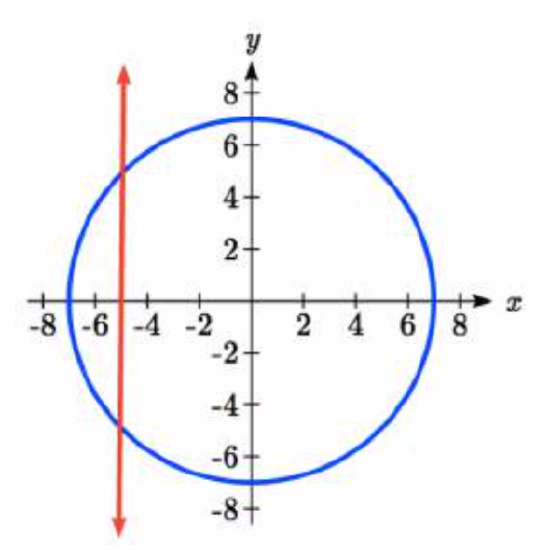
We can recognize this as one of our special cosine values from our unit circle, and it corresponds with angles
Exercise
Solve
- Answer
-
From our special angles, we know one answer is
Example
The depth of water at a dock rises and falls with the tide, following the equation
Solution
To find when the depth is 9 feet, we need to solve
While we know what angles have a sine value of
To deal with this, we can make a substitution, defining a new temporary variable
From earlier, we saw the solutions to this equation were
To undo our substitution, we replace the
Dividing by 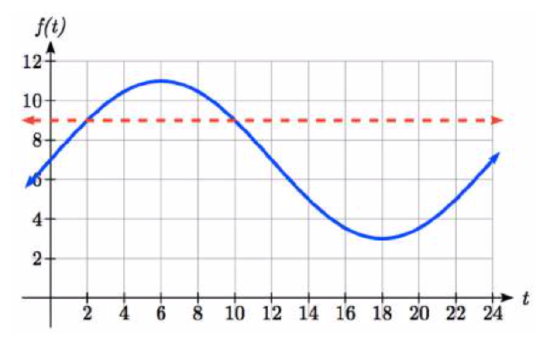
The depth will be 9 feet and the boat will be able to approach the dock between 2 am and 10 am.
Notice how in both scenarios, the 24k shows how every 24 hours the cycle will be repeated.
In the previous example, looking back at the original simplified equation
Exercise
Solve
- Answer
-
Solving using the Inverse Trig Functions
Not all equations involve the “special” values of the trig functions to we have learned. To find the solutions to these equations, we need to use the inverse trig functions.
Example
Use the inverse sine function to find one solution to
Solution
Since this is not a known unit circle value, calculating the inverse,
If you are working with a composed trig function and you are not solving for an angle, you will want to ensure that you are working in radians. In calculus, we will almost always want to work with radians since they are unit-less.
Notice that the inverse trig functions do exactly what you would expect of any function – for each input they give exactly one output. While this is necessary for these to be a function, it means that to find all the solutions to an equation like
To find additional solutions, it is good to remember four things:
- The sine is the
- The cosine is the
- The tangent is the slope of a line at a given angle
- Other angles with the same
Example
Find all solutions to
Solution
We would expect two unique angles on one cycle to have this sine value. In the previous example, we found one solution to be 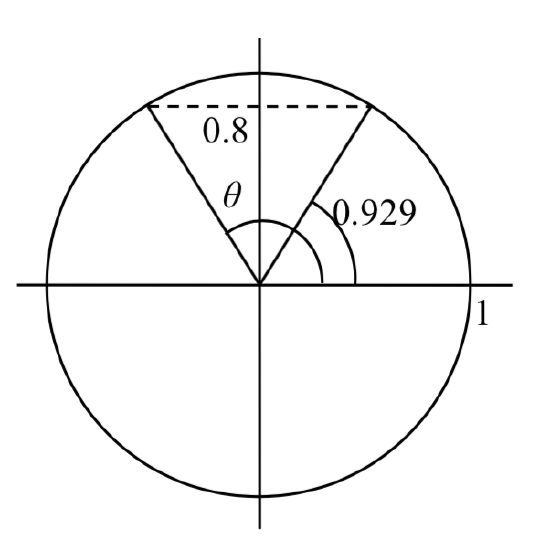
We can think of this as finding all the angles where the y-value on the unit circle is 0.8. Drawing a picture of the circle helps how the symmetry.
On a unit circle, we would recognize that the second angle would have the same reference angle and reside in the second quadrant. This second angle would be located at
To find more solutions we recall that angles coterminal with these two would have the same sine value, so we can add full cycles of 2
or approximately,
Example
Find all solutions to
Solution
We are looking for the angles with a 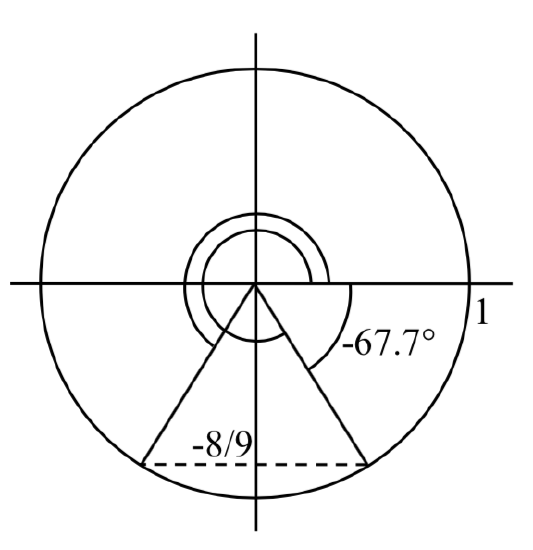 third and fourth quadrants.
third and fourth quadrants.
First, we will turn our calculator to degree mode. Using the inverse, we can find one solution
First, an angle coterminal with
There is a second angle in the desired domain that lies in the third quadrant. Notice that
The two solutions on
Example
Find all solutions to
Solution
Using the inverse tangent function, we can find one solution 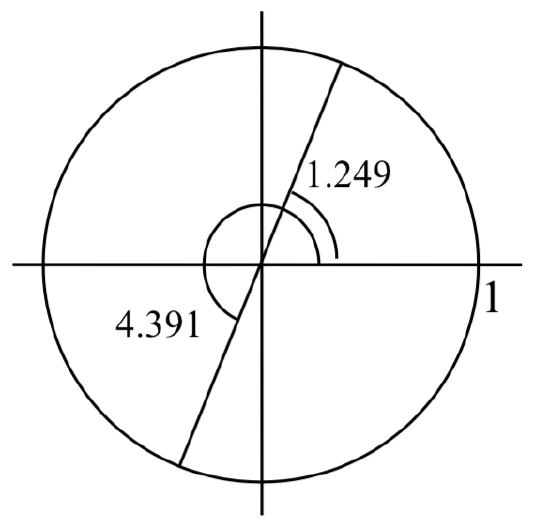
By adding
If additional solutions were desired, we could continue to add multiples of
The two solutions on
Exercise
Find all solutions to
- Answer
-
The first solution is
For a standard tangent, the second solution can be found by adding a full period,
Example
Solve
Solution
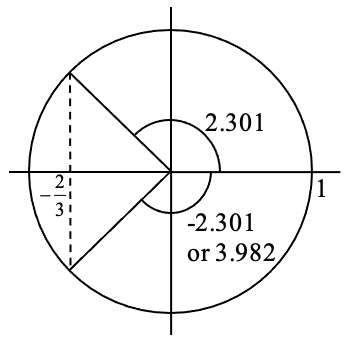
We’re looking for two angles where the
The equation has two solutions between 0 and 2
Example
Solve
Solution
As before, with a horizontal compression it can be helpful to make a substitution,
A second solution on one cycle would be located in the fourth quadrant with the same reference angle.
In this case, we need all solutions on two cycles, so we need to find the solutions on the second cycle. We can do this by adding a full rotation to the previous two solutions.
Undoing the substitution, we obtain our four solutions:
Example
Solve
Solution
This angle is in the fourth quadrant. A second angle with the same sine would be in the third quadrant with 0.730 as a reference angle:
We can write all solutions to the equation
Undoing our substitution, we can replace u in our solutions with
Divide by
Exercise
Solve
- Answer
-
Using the inverse,
Solving for
and
SOLVING TRIG EQUATIONS TRIGONOMETRY: SINUSOIDAL FUNCTIONS
- Isolate the trig function on one side of the equation
- Make a substitution for the inside of the sine, cosine, or tangent (or other trig function)
- Use inverse trig functions to find one solution
- Use symmetries to find a second solution on one cycle (when a second exists)
- Find additional solutions if needed by adding full periods
- Undo the substitution
We now can return to the question we began the section with.
Example
The height of a rider on the London Eye Ferris wheel can be determined by the equation
Solution
To find how long the rider is above 100 meters, we first find the times at which the rider is at a height of 100 meters by solving h(t) = 100.
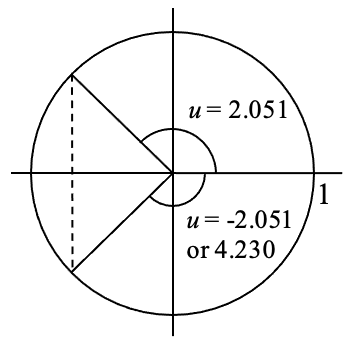
This angle is in the second quadrant. A second angle with the same cosine would be symmetric in the third quadrant. This angle could be represented as u = -2.051, but we need a coterminal positive angle, so we add 2
Now we can undo the substitution to solve for
A rider will be at 100 meters after 9.793 minutes, and again after 20.197 minutes. From the behavior of the height graph, we know the rider will be above 100 meters between these times. A rider will be above 100 meters for 20.197 - 9.793 = 10.404 minutes of the ride.
Important Topics of This Section
- Solving trig equations using known values
- Using substitution to solve equations
- Finding answers in one cycle or period vs. finding all possible solutions
- Method for solving trig equations


